The Q&A: Matt Chlebek, vertical farmer and space-age grower
A visit to a nondescript industrial estate in East London provides a fascinating glimpse into the future of food
You’re reading The Earthworm, a newsletter that takes a sideways look at the world of gardens, gardening, horticulture and all that good green stuff. If this is your first time here, you can catch up on anything you’ve missed by following this link. Subscribe now for free and join the community! You can also support me and my work on The Earthworm by upgrading to a paid subscription at any time – just tap the button below.
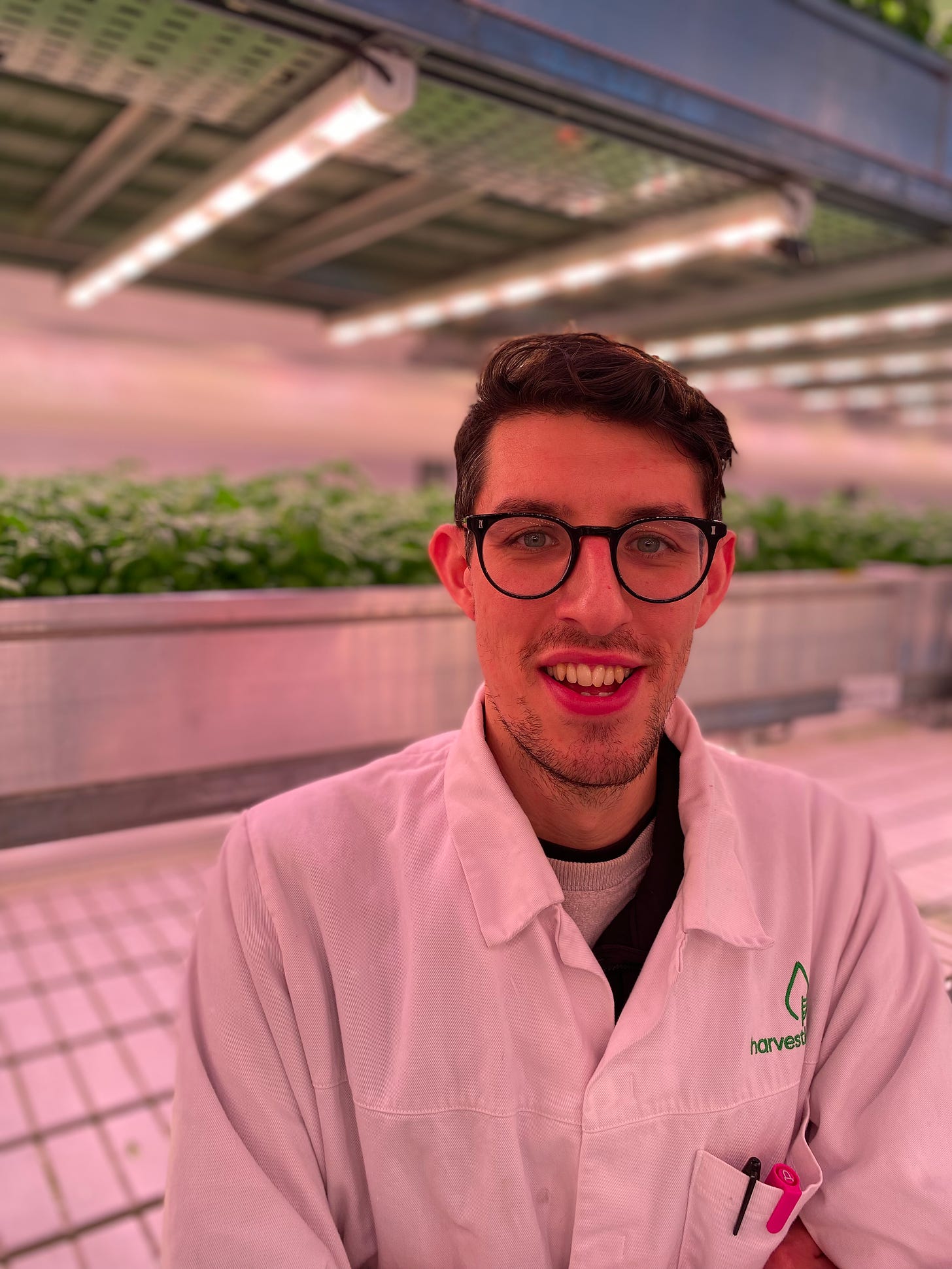
“The future of food” is a familiar and endlessly fascinating phrase. To headline writers, anyway.
It’s not just the words that capture the imagination; the futuristic food solutions themselves tend to live up to this science fiction phrasing. The trouble is, from insect proteins through to specially formulated, nutritionally complete shakes, these future foods are as unappetising as they are far-out.
Which is a shame, because never has it been more important to find radical solutions to the way we produce our food. I just can’t stomach the idea that the answer lies in grasshopper burgers or lab-produced gruel.
More palatable, and finding a more encouraging balance between cutting edge science and sustainable growing practices, is the concept of vertical farming. This basically boils down to growing crops indoors under special lights, and usually hydroponically (which is to say not in compost, but in a specially formulated liquid solution). By eliminating the plants’ reliance on silly old things like, you know, the sun, and soil, you can set up these vertical farms basically anywhere. Basements, disused car parks, warehouses – you name it, someone has tried growing a lettuce (or more often than not cannabis) there.
In an old industrial estate near Lea Bridge station in East London, where the urban infrastructure of Walthamstow gives way to the verdant beauty of the Lea Valley, there sits an unremarkable brown-brick warehouse. Inside, however, is something far more remarkable: Harvest London, aka the future of food.
I went to visit a few weeks ago to meet Matt Chlebek, Harvest London’s co-founder and chief agronomist. After gaining an undergraduate degree in biology and, later, a master’s degree in plant genetics, Matt’s career took a number of interesting twists and turns – from Head of Events at Soho House to setting up his own record label – before he finally landed where he is today. That is, one of the UK’s first vertical farmers.
Lab coat aside, Matt comes over more recording studio than laboratory in his demeanour and style, but there’s no denying the scientific sophistication of what he and the Harvest London team have built in this unassuming space. The warehouse hums with the sound of pumps and fans, sounding more factory than farm. At its centre is an internal room, and the heart of the operation – the farm or grow room itself – its artificial lights glowing pinkly. A satisfyingly retro control panel which Matt can operate by hand, on his computer, or even using his phone, sets the air temperature, humidity and “daylight” hours inside the farm.
As we enter the grow room itself, I’m immediately struck by the sweet, intoxicating smell of basil. Thousands and thousands of bright green, perfectly uniform and decidedly delicious plants. Every single leaf growing during my visit (apart from the box that I took home with me), was destined for local restaurant chain Pizza Pilgrims. That’s how the business model works: grow-to-order. The restaurant places an order, and the Harvest London team gets sowing. Four weeks later, the basil is delivered by bike to the restaurant, where it can garnish a margherita just a few hours after being harvested.
I talked to Matt about hydroponics, the so-called future of food, and playing god, among many other fascinating subjects. Food for thought, indeed. Tuck in.
This interview has been edited for length and clarity.
So what is this place? What are you doing here?
Broadly speaking, this is vertical farming, which is a subdivision of controlled environment agriculture. What it does is it combines hydroponics – which is growing plants without soil, in or near water – and LED lights, and climate control into one thing. We set the temperature, we set the humidity, we set a few other things surrounding what we want the water to be like, we tell it how much light we want, and then we let it go.
How innovative is that approach?
Hydroponics is nothing new. Whether it's the Hanging Gardens of Babylon or Chinese floating rice paddies. The thing that makes this possible is really the lights. Before, lights were metal-halide and produced loads and loads of heat – you couldn't cool a grow room like this, so it got too hot and everything died. What’s new is we now have cool-ish LED lights with relatively low energy consumption – compared to what was happening before – and more affordable too.
We didn't invent any of this technology. The piping we use is horticultural piping. The tanks are from people that make tanks for greenhouses. What’s new is how we combine it, and the way we operate the farm, and the way we use software, and the way we use plant science. That’s the novel bit.
Water is the growing medium. All the nutrients that the plant needs in order to grow have to come from the water, and the water alone. So, what’s in it?
We use mains water, and then put plant food, fertiliser, in it, which is a fairly standard off-the-shelf mix. But then on top of that, we add our own proprietary blend of extra stuff specifically tailored to basil. Basil loves magnesium, for example, so we add loads of magnesium to the water.
When you start growing things like tomatoes, aubergines, cannabis, it becomes much more complicated. You have to give them different types of nutrients at different stages in their life cycle. But with basil and a couple of other crops that we grow, we're just growing it in four weeks from small plant to slightly bigger plant – once you've established what it needs, you just set it up and let it go.
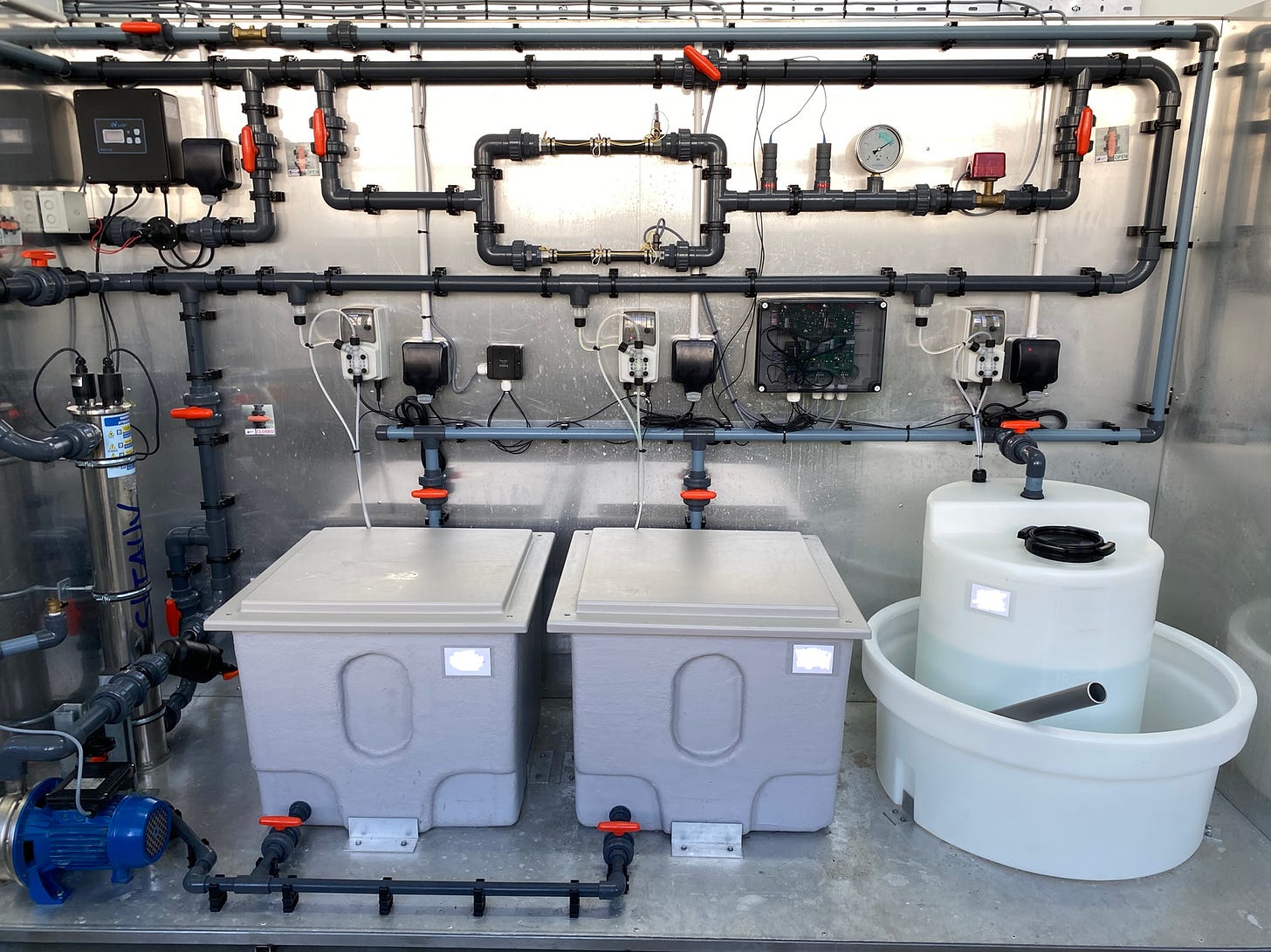
Talk me through the grow room itself. How big is it? And how many plants can you grow in there at any one time?
It’s an 80 square metre floor space, which gives us 153 square metres of growing space. We have two racks, each with four levels, which gives us a total of 64 benches. Each bench holds 16 modular trays, and each tray holds 35 plugs. Each plug has an average of, say, four plants in it. So if the farm was 100% full, we would be growing 143,360 plants. In practice it’s less, because while we don’t thin out individual plants, we do space out the plugs within the trays.
Still, that’s a lot of plants. In this case, a lot of basil plants. How does your choice of crop affect the microclimate that you create inside the grow-room?
We tailor our farm to basil, because that’s our main crop. If we grew loads of lettuce, the environment would be different. If we grew loads of parsley, the environment would be different. For tomatoes, we would need a different shaped farm, to allow for the size and growing habit of the tomato plants.
So the grow room is kept at 27 degrees celsius during the day, and cooler at night. That's because we have found that that produces nice basil. And because of the way that energy pricing works, the plants' daytime runs from 9pm to 3pm, and then the lights go off between 3pm and 9pm, and that’s just because energy is more expensive during our evening.
Right, because it doesn’t matter what the sun is doing outside – the plants’ day and night is governed purely by when you decide to turn the lights on and off.
Yeah. They need some darkness because certain physiological things that a plant needs to do only happen when it's dark, but what time of “day” that happens, they don’t care.
So how did you come about your specific climate recipe, then?
We started off by looking up what the climate is like in Liguria, where they grow the DOP Italian basil, and we punched that into the system. And then over time, what we did is we fiddled gradually with those numbers. It’s this slow experimental process of: change a thing, let it grow, see how it does, then change one of the many variables in one direction or another. And what we’ve found is that, you know what, whilst basil grows great outdoors in Italy at a different temperature, we can push that harder in a controlled environment to make the plant grow quicker.
And that speed is of the essence, is it?
Yeah. Really what we're after is speed of growth and density of growth, right? Because the faster we can grow stuff, the more productivity we can get out of our farm; the closer we can grow stuff together, the more productivity we can get out of our farm.
You’re growing basil because your customer has asked you to grow basil. But in theory, could you grow anything hydroponically in the farm, under lights, as long as you adjusted the climate settings accordingly?
My view is that in theory, you could grow anything. But the first thing we need to ask is whether it's worth doing it, economically: how long does it take to grow versus how much can you sell it for. Because the longer it takes to grow, the more it costs us to grow. It’s similar outside, because the longer something is in the field not getting sold, the less economically efficient it is. But it’s not quite the same outside, because the sun is free…
And then we’ve also got structural limitations. Like, our shelves are 700mm apart, so we can’t currently grow something that needs more height than that. But on a differently set out farm, we could.
One of the things I wanted to ask you before I came here was, to what degree can people replicate this at home? But seeing it for myself, it seems that that would be impossible…
You could, you could. You can take a cup or a bucket or a yoghurt pot – anything that holds water – put some water in it, put some tomato feed or whatever in there, and stick a covering on it to black it out, otherwise you’ll get algae growing in there. Then you put your plant in and you’re ready to go. If you go on the subreddit for hydroponics, there's 25 different ways of making that more complicated, but it doesn’t need to be.
So, other than basil, what have you grown here?
I think we've probably grown 200 different things. That includes 25 different types of basil, but also every standard herb. And then things like Peruvian black mint and bi-coloured shiso and oyster leaf – all sorts of weird things. Salads and herbs and lettuce. And then we've also had everything from radishes to carrots, cherry tomatoes, chillies, aubergines. And they grow great. They could grow better, because that environment is not tailored specifically for an aubergine. And also it is probably not economically viable to grow an aubergine in there.
I don’t think it can be overstated how much of a game-changer it is to be able to grow to order, and produce a reliable, consistent crop that isn’t susceptible to pests or diseases – and without the need for pesticides. Traditionally you would fill your field with, say, potatoes, then hope for the right weather, hope for a disease-free season, and hope that there will be a demand for potatoes when it comes to harvest. Here, you don’t have to hope; you can just grow when the orders come in. So there’s no feast or famine, no glut and no waste.
No. I mean, not from our end anyway. We're incredibly consistent. Everything that goes into that farm in terms of the seed comes out of that farm in terms of the usable, sellable crop. And because of how close we are to where our customers are, the stuff lasts longer. It turns up and it's all usable. I've been in kitchens before where deliveries have come in, with even something like cabbage or kale, and half of it's been mangy and yellow, because it's travelled all the way from Europe, and it's gone straight in the bin.
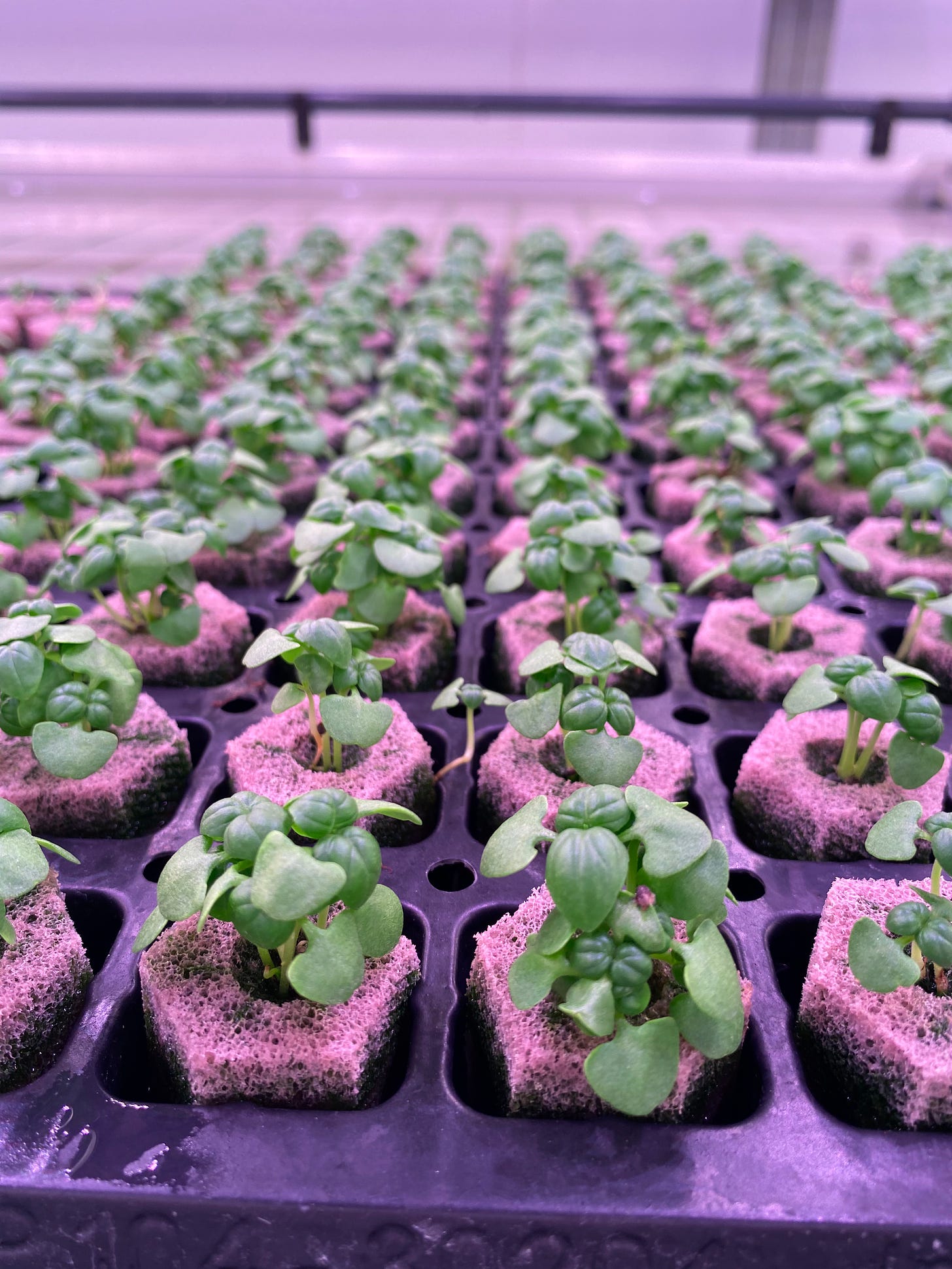
We’ve all experienced the disruption and associated price hikes brought about by Brexit, Covid, and surging oil prices – in that context, I can see how urban, indoor, vertical farming could be a brilliant solution to tackling the broader food crisis. Having said that – and not to disparage what you’re doing here – if all we’re growing is basil, that’s not exactly going to feed the world, is it?
I'm not claiming that we could feed society on basil. But by growing a product here, now, that we can sell and make money off, and make a business that works, it means that in 10 years’ time, or some point in the future, we will be part of an industry that there is demand for, and that will make progress towards growing potatoes and rice and wheat and soy and all these things that we see as what we need to feed ourselves on.
I know there are limitations on this specific farm here, but that's short-term. The lighting manufacturer is not going to make their lights more efficient and cheaper if we're not buying them in the first place. What we're doing is we're taking a bit of a leap of faith and saying, we know that this business works now, and there's no reason why it can't work for other crops in future if collectively, as an industry, we can get the economics right.
Right, so this is a proof of concept as much as anything else?
Exactly. And so the next sensible stage is, okay, what about aubergines, tomatoes, peppers, cucumbers, which are already all grown indoors anyway? Thanet Earth, which is down towards Margate, is this glasshouse complex the size of which you wouldn't believe. It's got artificial lights – so much that if you're driving around there at night, it looks like the sun is coming up because the pink light is leaking out through the glass roof. They supply peppers and cucumbers and tomatoes to Sainsbury's and Tesco.
If anyone complains about what we’re doing you have to say, well, where did you think your tomatoes come from in December? Really all that we're doing is we're doing it in a different shape. And because we've got a lid, and some walls, we have a bit more control over the process.
Traditional gardeners and growers, depending on their approach, are either working with nature or fighting against it in order to get their plants to grow. One of the things that’s striking to me about what you’re doing here is that you’re almost eliminating nature from the equation entirely. You control nature. You are playing god.
Yeah, and part of me doesn't like that at all. I love the idea of going to a restaurant where the chef is getting seasonal produce and thinking about it, and doing all this cool stuff. But it’s just not the reality of how things are.
One of our customers floated the idea of seasonal planting. And we could do it, of course. We could turn the temperature down in the winter and grow this, and then turn the temperature up in the summer and grow that. But you start asking yourself: what's the point? Because if you're growing the stuff that grows in the summer, in the summer, don't grow it here. Grow something else.
Take tomatoes though. Tomatoes grown in glasshouses in December are pretty rubbish. But there’s no reason, theoretically at least, why we couldn't grow the tastiest, most incredible tomatoes all year round. Other than that we just haven’t built our facility for it. And I think there's something really exciting about that.
Is it all a case of learn-by-doing? Trial and error? Or is there a textbook to follow?
It's really hard to find reliable, consistent knowledge about what we do. Because everyone's farm is different; everyone on the internet’s a dickhead; and a lot of the received wisdom about how you grow in other types of growing media isn’t applicable. So so much of what we do has to be based on academic research and then adapted for the real world. Or real world practice and then adapted to be large-scale and realistic.
The people that are amazingly helpful are Philips, who design our lights. They've got 10 of these farms that are purely just for developing lights, and they have to grow stuff underneath them. So if I call them up and say, ‘What have you found out about basil recently?’ They'll go, ‘Well, you'll never guess what…’ And they'll happily tell us because we're their customer.
I would imagine that a lot of the hydroponics literature that’s available online relates to cannabis production.
Yeah, there’s a lot related to that, which is very close to growing tomatoes. Apocryphally, when cannabis legalisation became more widespread in the US, the salaries that headhunters were offering tomato growers in Holland went through the roof. It was seen as the most transferable skill, so they were getting poached to go over to America.
So what crops are on your wish-list for the future of the farm?
I’ve always wanted to try hops. And we are obviously very interested in the cannabis industry, when it becomes legal. And then because of my background, I’m fascinated by the idea of using plants to grow biopharmaceuticals: vaccine components, therapeutic drugs for arthritis, and all these sorts of things. It's a massive industry. Vertical farming doesn't have to be only about feeding people – this is just the start. It might be that in five years’ time there's other really good uses for this outside of putting herbs on your plate. But you've got to take things one step at a time. That for me is exciting.
With an undergraduate degree in biology and a master’s in plant genetics, you've obviously got an academic grounding in plant science. But what about personally? Where does your hands-on plant knowledge come from?
My mum, and to some extent my dad. My mum loves gardening. She never grew many vegetables, but through hanging around with her, and through education, I knew enough when getting into this about how plants grow.
The other side of it is, my dad was an engineer. He basically lived in his garage, building motorbikes, building cars, building clocks, building all sorts of mad stuff, and I used to hang around with him all the time. So I know quite a lot about how plants grow, and I also know how a spanner works, and how to fix stuff, and without those two things we wouldn’t have got very far.
And do you garden? Or grow veg at home?
Now that I have this place, I have no real interest in growing plants in my garden at home. I love my garden and I like keeping it nice, but I don't go to the garden centre on weekends. And I don't do the weeding every weekend. I’ll do it when it needs doing, and I'll trim the roses back when they need doing, and I'm proud of it when it looks nice, but it's a bit of a busman’s holiday when I've got all of this to look after.
It must be incredibly frustrating. Here, you have complete control over how things grow. But in your garden, you’re at the mercy of mother nature…
Yeah, I think that's why I started to give up. That's why my veg patch at home, as this place has got better, has got worse. I can’t be bothered to build a fortress to protect my plants from squirrels. I find myself with a head-torch on at night, picking slugs off my cabbages, and I'm like, ‘I can’t be doing this.’
What really interests me is how technology can be used to make plants grow. And I know that through applying this cool technology and through the ways we work, the plants will grow really well. Through doing what we do, you can take a step back and you don't have to be micromanaging your crop. And as a result, we have a lot fewer problems, and a lot fewer worries. And there’s no weeding to be done.
What did you make of this interview with Matt? Do you think vertical farming is the future of food? Or would you rather eat an ant? Leave a comment and let me know!




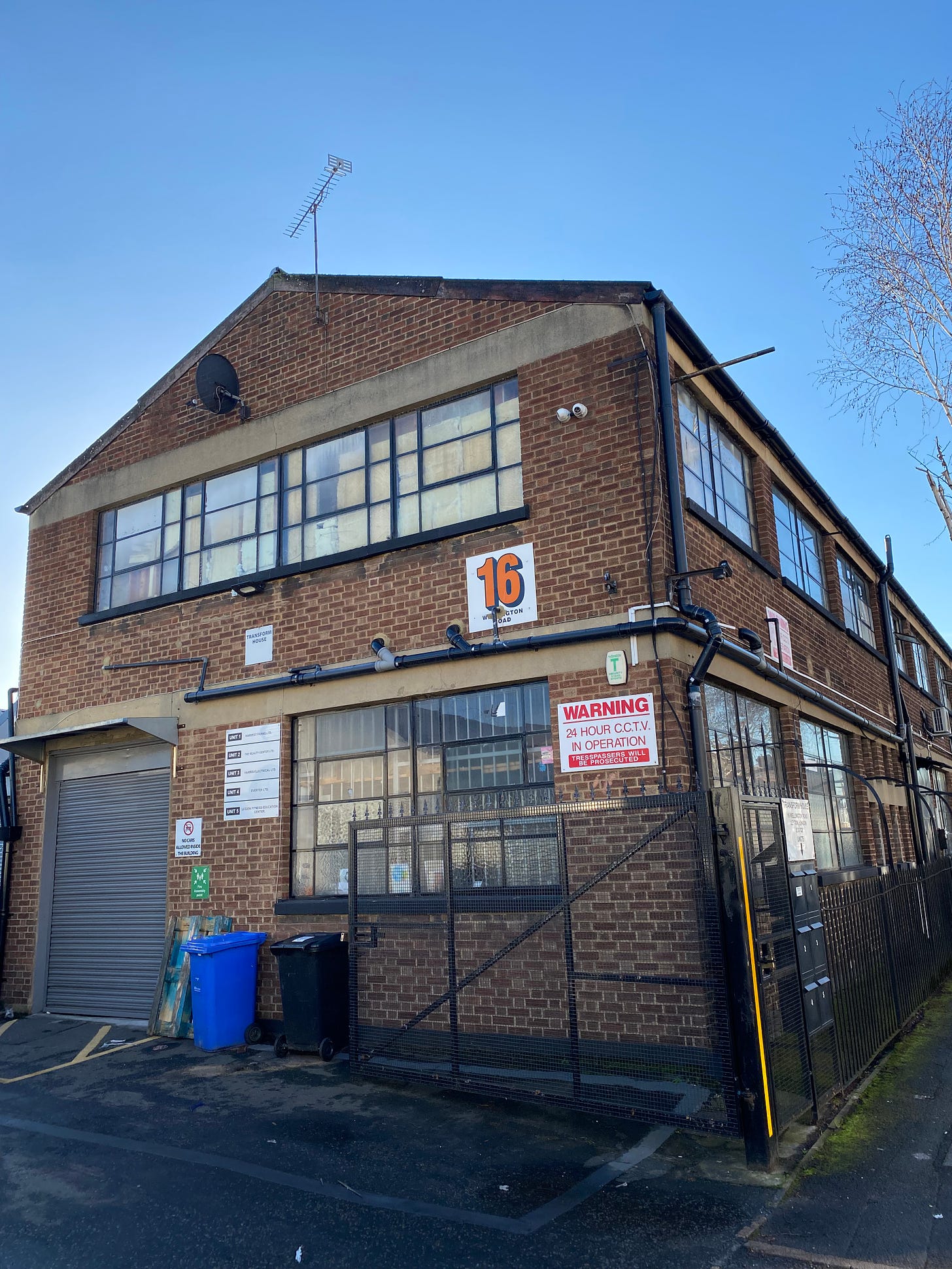
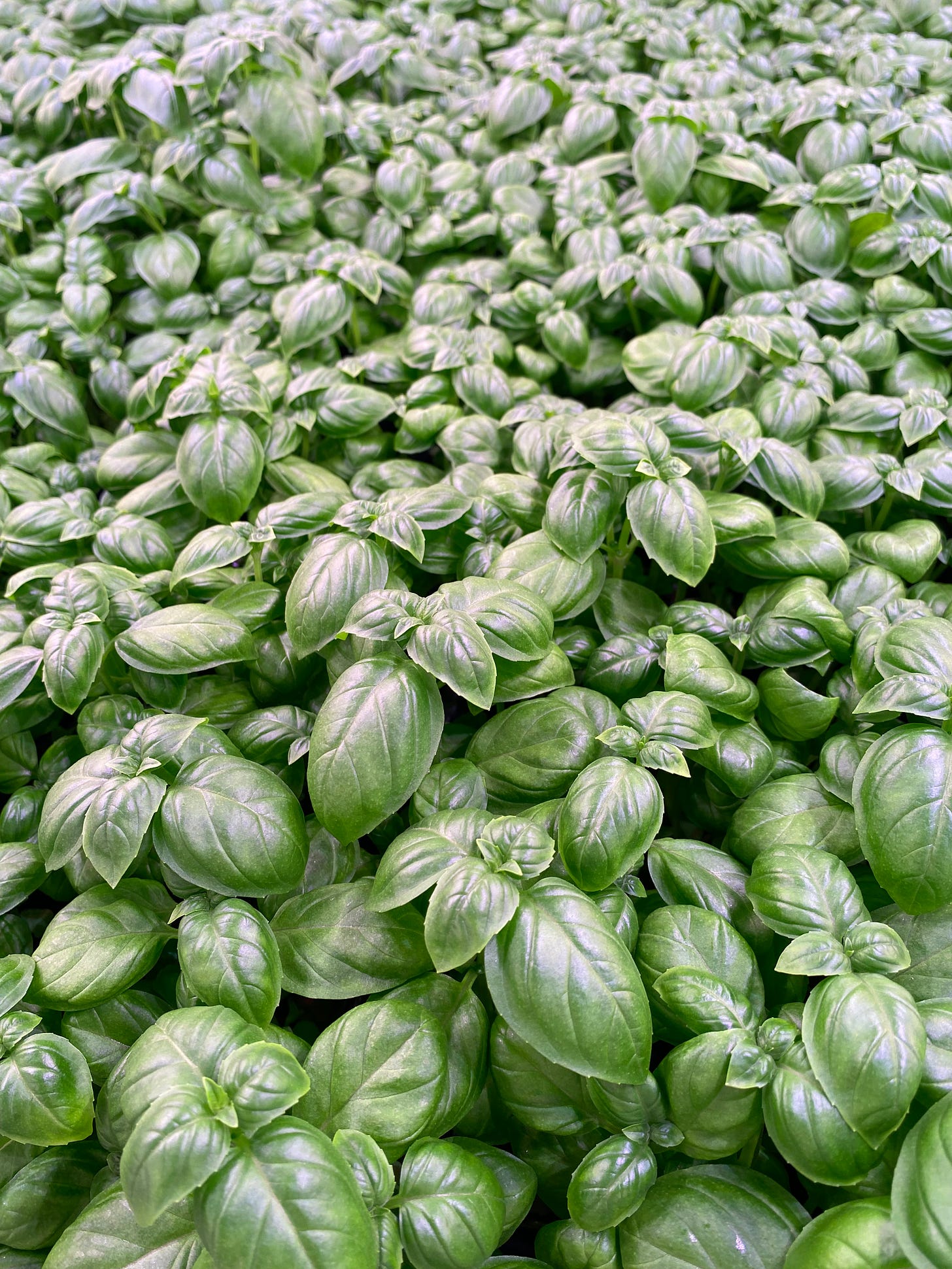
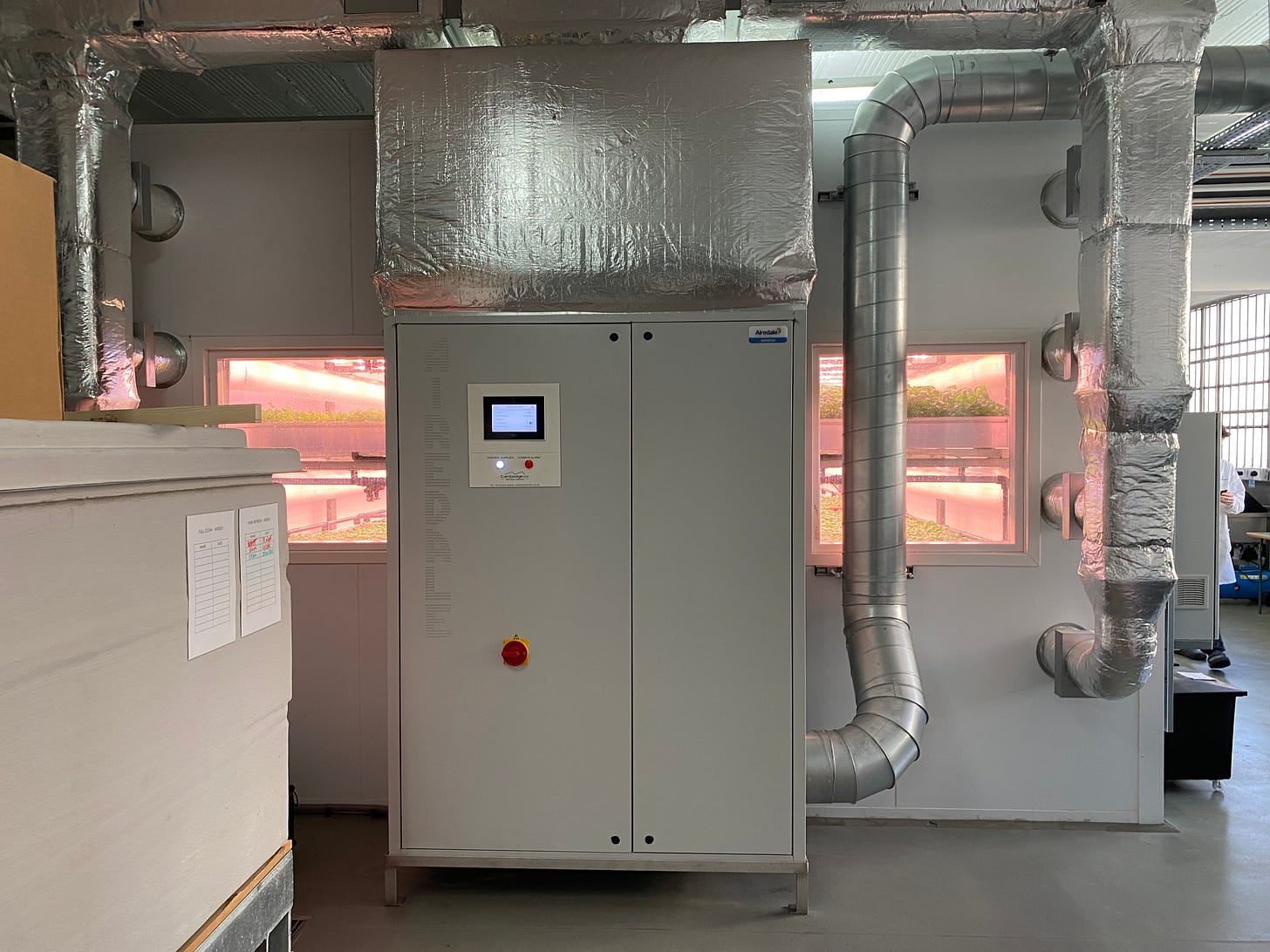
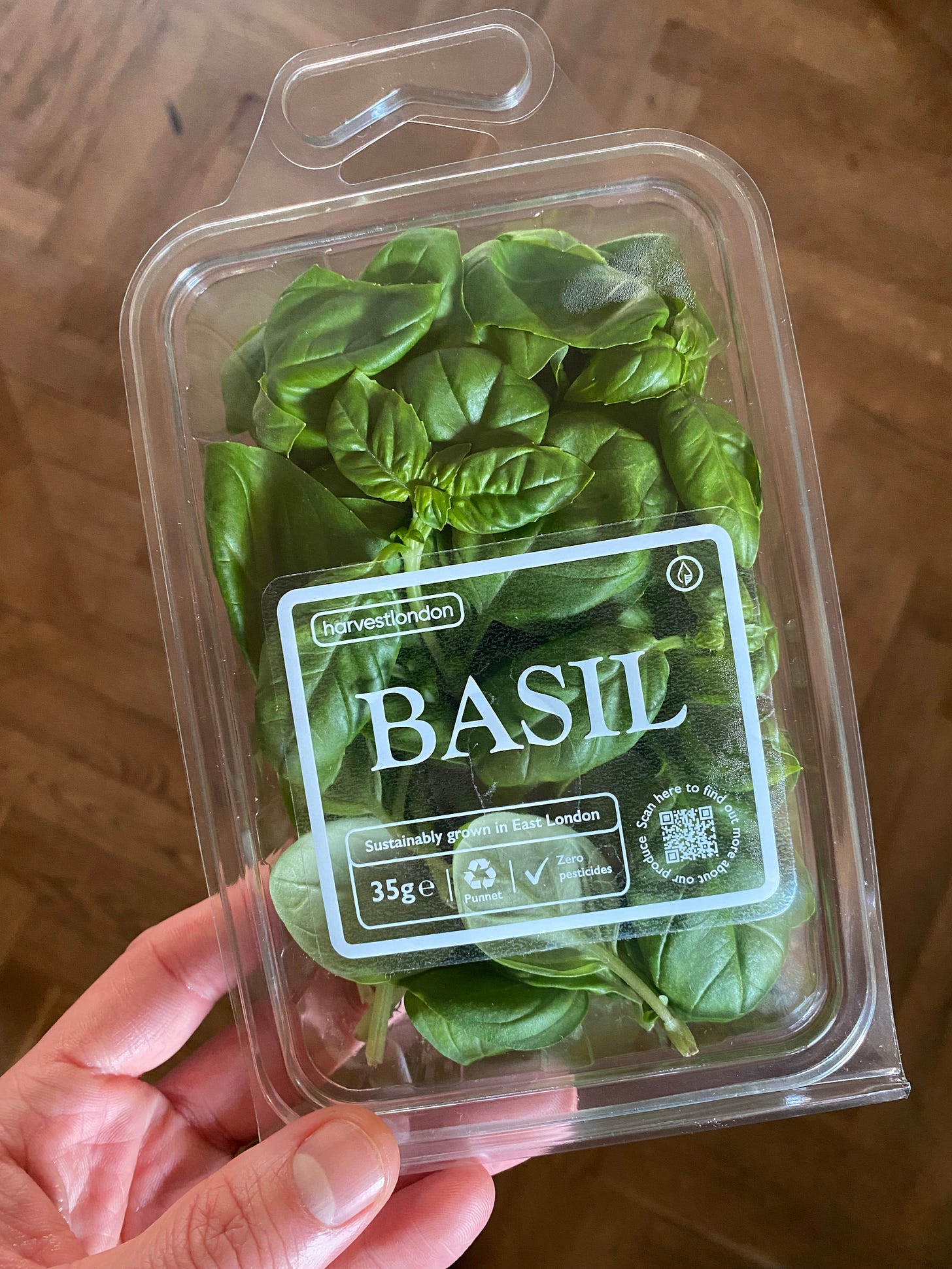
Very interesting, had no idea this was just up the road. I'd love to compare the taste of a tomato grown in this kind of environment to a homegrown one.
This was really interesting! Thanks for sharing it.